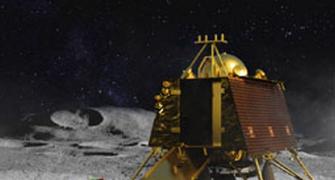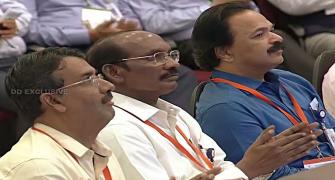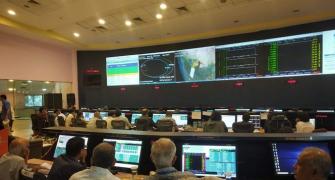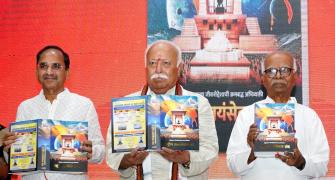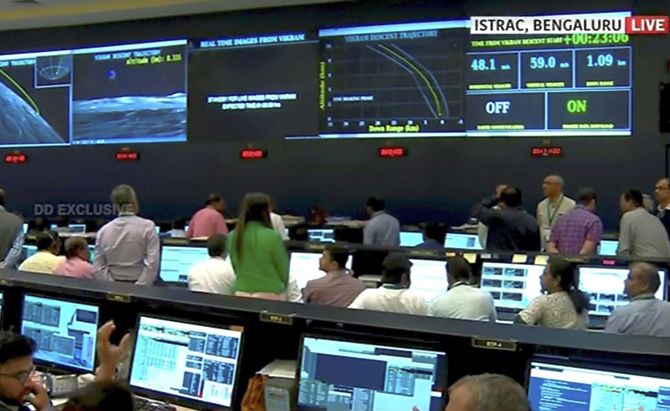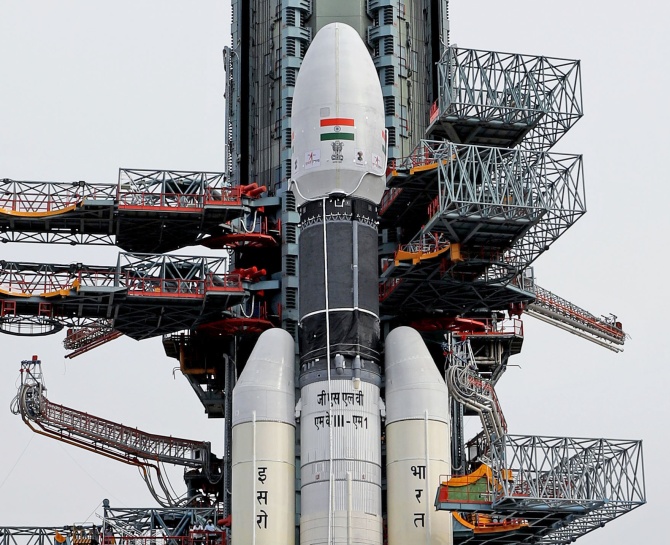'If Chandrayaan 1 had a launch with GSLV, we need not have an orbiter for Chandrayaan 2.'
'We could have gone straight round the moon and landed on the moon.'

It took many years of relentless battle for former ISRO scientist Dr Nambi Narayanan to be liberated from the unfair and unjust tag of being a spy.
It was in 1994 that he was falsely charged and arrested for espionage.
Though the charges against him were dismissed by the Central Bureau of Investigation in 1996, and the Supreme Court of India declared him not guilty in 1998, it was only in 2018 that the Supreme Court ordered the Kerala government to compensate him with Rs 50 lakh.
The apex court also constituted a committee headed by a retired Supreme Court judge to inquire into the role of the Kerala police officials in his arrest.
The Narendra Modi government awarded him the Padma Bhushan in 2019.
As an expert in liquid propulsion, Dr Nambi Narayanan was in charge of the cryogenic division at ISRO when the case erupted. It was his team that developed the Vikas engine which was used in the PSLV and also in the GSLV.
"The (ISRO spying) case erupted in 1994 and if not for that, we would have had the cryogenic system by 1999. Then, we could have launched the Chandrayaan mission in 2001. But it was available only by 2014," Dr Nambi Nararayan tells Rediff.com's Shobha Warrier.
As a former ISRO scientist, what was on your mind when Chandrayaan 2 was going up in the sky?
I was watching it live and the moment the diversion took place, I felt it was going to be a problem. It was painful to see it happening, having come all the way.
I read someone saying that it was 95% success. Does that mean the contribution of the rover part is only 5%?
Some people said it is nearly successful... it almost made it... How do you quantify these statements?
In science and technology, there is nothing called 'almost' or 'nearly'.
In my opinion, it was not a failure. When do you say a system is a failure?
According to me, it is a failure when you do not know why it failed, and when you are clueless about the problem.
If you know the reason for the failure, the problem can be solved in the next mission.
That's why I say it was successful as far as the orbiter mission was concerned.
But you cannot forget that the aim of the mission was to have a soft landing on the south pole of the moon. In fact, soft landing was the mission's only criticality.
It is also a fact that there is no difference between Chandrayaan 1 and 2 except for soft landing. So, that was the critical part of Chandrayaan 2.
Does that not mean it is a failure because the most critical part of the mission failed?
There are many ways you can look at the entire mission.
Here, I would like to draw your attention to something else. While the first mission was with PSLV, this was with the GSLV. Why did they have to launch Chandrayaan 1 with PSLV? Because GSLV Mark 3 was not available.
In other words, the cryogenic system was not available.
Why was the cryogenic system not available then? Because of the so-called ISRO spy case.
The case erupted in 1994 and if not for that, we would have had the cryogenic system by 1999. Then, we could have launched the Chandrayaan mission in 2001. But it was available only by 2014. It took 12-13 years for us to achieve that.
At that time, we didn't know how long we had to wait for GSLV. So, a decision was taken 2003 or 2004 to have Chandrayaan 1 with PSLV. In fact, Chandrayaan 1 was redefined for PSLV.
If Chandrayaan 1 had a launch with GSLV, we need not have an orbiter for Chandrayaan 2. We could have gone straight round the moon and landed on the moon.
We should not get confused in defining the aim of the mission. For example, you take the Mars mission. The definition is to demonstrate the technology, that is, we can go to Mars from Earth in such a manner.
If your aim is to soft land on the moon, why do you need an orbiter?
Why I am thinking this way is since you already had an orbiter, why do you need to carry the extra weight of the orbiter again?
If there was no orbiter, you would have put all the efforts into the soft landing part of the mission.
I am of the opinion that the problem occurred in the entire controllability of the spacecraft, and that is the reason for this failure though it is yet to be confirmed by ISRO.
If you compare our lander with that of the Chinese, you see that they use larger number of thrusters. They use many thrusters because they have realised the difficulty in controllability in soft landing.
Controllability is the step before soft landing. If you cannot control the system, you cannot soft land. That's why the Chinese use many thrusters for controllability.
Because we have used lesser number of thrusters, controllability became a problem.
Why did we use lesser number of thrusters? Because we have a dead weight called the orbiter.
You mean, when the main objective of the mission was soft landing, the orbiter should not have been there.
Why I am saying this is, we must define the primary objective of the mission.
If soft landing was the primary objective of the mission, we would not have compromised on the number of thrusters.
But in this mission, they have given equal importance to the orbiter also, and it carries eight payloads.
I have my own doubts about the requirements of the orbiter itself.
If you look at the published information of the lunar surface, there is plenty available. I do not know what additional information you are going to gather. That's why I feel soft landing should have been the primary objective.
I have no intention to question or hurt anybody. As a scientist, I am just analysing after its failure, on what would have saved my mission.
What is more important in such missions is you have to be clear about your aim. The present ISRO should have a vision statement for the next 10 to 15 years at least.
Then they should calculate the estimated cost of the mission to approach the government for funds. Only then you can do a mission in a systematic manner.
You wrote recently on the need to have an Asian Space Agency. Why do you feel that is the need of the hour?
I am of the opinion that there has to be an Asian Space Agency like NASA and ESA for the Asian region. This agency should have all the Asian countries including the Gulf nations, China and Japan.
Imagine, there will be 23 countries in this while ESA is a group of 13 countries with France as the leader.
The problem is, we are not united in the Asian region.

What is the advantage of having such a union?
First of all, all the countries can share the funding. Even the annual budgets of many nations will not meet the cost of deep space missions like Chandrayaan, Mangalyaan, etc.
On the other hand, when a group of countries work together, funding will not be a problem and the benefit also goes to everyone. And there will not be any competition among the member countries.
When you launch a deep space mission like Chandrayaan, you have to control it or command it from some other country. If it is a member country, you can have such controls anywhere there.
So, the advantages are many.
What about China and Pakistan? Will they agree to such a union?
Yes, these are the two problem countries. China may join if you talk to them in a diplomatic way. Pakistan will not.
It is definitely advantageous for China because they can make use of Sriharikota for launches. They also get a payload gain of 50%-60% as we are closer to the Equator.
Japan has already signed an agreement with India for the next Chandrayaan mission.
Though China claims so many things, I don't think they are very advanced in space technology. They only have a slight edge over India, that too because they have a powerful booster while India has only two liquid engines -- the Vikas engine and the cryogenic engine.
Who should take the initiative to start an Asian Space Agency?
India alone can and should take the initiative. India should claim the leadership and talk to China.
It is high time India did this as it is advantageous for us financially, strategically and business-wise.
I would say the space missions of tomorrow will not be possible unless NASA, ESA and ASA join hands.
I have a feeling that the others may get worried about the formation of ASA because this will be a formidable agency that will have money.
Formation of ASA will be a wonderful day for space programmes.
You said the ISRO spy case delayed India developing the GSLV by 26 years. Do you think there was an international conspiracy behind the case?
Just see who are the leading countries in this business. They may not like to have a competitor like India. Yes, there is a foreign hand behind the case, but they didn't come here to do it. Somebody in India executed it.
A film on you is coming soon...
My biopic is being made and R Madhavan is playing me. It will be released in November or December.
When Madhavan approached me with the idea, I asked him who would watch a documentary on me. But he was insistent and when I read the script, I liked it. The film ends with me getting the Padma Bhushan.
I had to fight for years to clear my name. I didn't want my children and grandchildren to be known as the children and grandchildren of a spy. I can't go giving them a bad name. That was why I continued my fight till I won.
I said yes to the film because films have a better reach. And they have made the film very emotionally.
But when I asked my son and daughter to come and watch, they refused. They said, they didn't want to relive the experience again!

